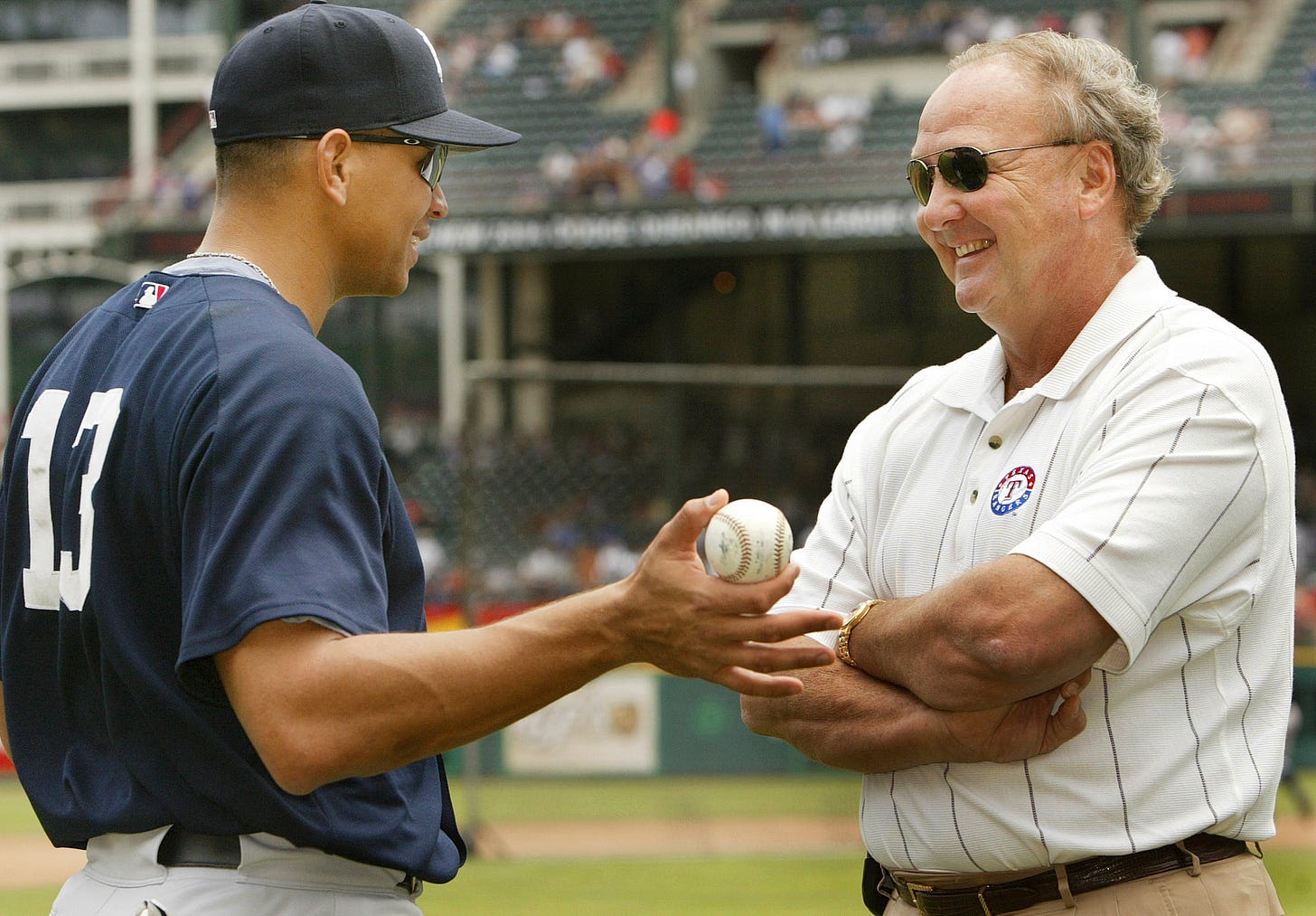T.R.'s Memoirs: How the Alex Rodriguez Era with Texas Rangers came to an end
A-Rod's discontent with the direction of the Rangers grew as they struggled to build around their superstar.

Editor’s note: T.R. Sullivan covered the Texas Rangers over 32 years for the Fort Worth Star-Telegram and MLB.com and is sharing his “memoirs” with this newsletter. In this installment, T.R. covers the events of 2003 that led to Alex Rodriguez being traded to the Yankees before the 2004 season.
Cal Ripken was calling pitches for the Orioles pitchers from his shortstop position.
Or maybe it was Derek Jeter telling the Yankees pitchers what to throw. Can’t remember which one it was.
But Alex Rodriguez decided he, too, wanted to call pitches from shortstop, sending signals to the catcher and have him relay it to the pitcher.
This was in 2003 and the Rangers’ catcher that season was Einar Diaz, acquired from the Indians after Ivan Rodriguez left as a free agent. Rodriguez no doubt thought he was better at calling pitches for a pitching staff that finished with a 5.67 ERA, the worst in the major leagues.
He may have been right, but pitching coach Orel Hershiser didn’t think so. It was Hershiser’s responsibility to put together the daily game plan for his pitchers and he had no interest in his shortstop overruling him.
There aren’t many pitching coaches who would dare call out Rodriguez, the team’s best player and personal favorite of owner Tom Hicks. Not Hershiser, a former Cy Young winner and World Series MVP who thought, with some justification, he belonged in the Hall of Fame.
Hershiser backed down to no one. He told Rodriguez to worry about shortstop and leave pitch calling to others. Rodriguez was furious at the rebuke and made it clear Hershiser needed to be fired. Manager Buck Showalter was left to deal with the mess.
Showalter also had to deal with another mess at the end of the season, when clubhouse manager Zach Minasian fired one of his young assistants Tommy Bolin. The move infuriated Rodriguez, and it became a major issue between him and Showalter.
So here is the way a major-league clubhouse works …
Each team has a full-time clubhouse manager, many of whom keep the job for years and years if not decades. Joe Macko was the Rangers’ first clubhouse manager and held the job for over 20 years. The Rangers have had just three since then: Minasian, Richard “Hoggy” Price and Brandon Boyd, who currently has the job.
The clubhouse manager has about six assistants — more or less — and among their job is tending to any player needs. Third baseman Ken Caminiti once brought his dogs to spring training, gave an assistant $100 to go buy dog food and just keep the change.
At the end of the year, the players all give money to tip the “clubbies,” as the attendants are informally called. It’s a huge source of revenue, and the attendants are supposed to divide it equally.
The problem with Bolin was he became Rodriguez’s personal “clubbie.” Rodriguez trusted nobody else and Bolin handled everything for him. At the end of the 2003 season, Rodriguez gave Bolin an enormous tip, which was very generous of him.
The problem was the money went straight to Bolin, rather than being shared by all the clubbies. That didn’t sit well with Minasian, and that was it for Bolin.
“The agreement when we hired him was, he worked for the Rangers and me,” Minasian told Jim Reeves of the Star-Telegram. “This is a season job for high school and college kids to work 81 days a year. It’s not to have personal valets or anything like that. I had to stop it before it got out of hand.”
It got out of hand.
By the end of the 2003 season, everything concerning Alex Rodriguez was out of hand, and thus began the unceremonious exit of the highest-paid marquee player in Rangers history.



